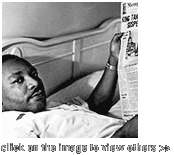 |
|
July 2002
"Pictures Tell The Story" was the logo on the awning
of Ernst Wither's photo studio in Memphis for fifty years.
Had he confined his practice to weddings and funerals, debutante
balls, church leaders and Sunday School classes, he would
be forgotten. But against all odds Withers became one of the
premier African-American photojournalists of the 20th century,
on a par with colleagues Frederick Roberts and Gordon Parks.
Wither's own story, untold in the pictures, is also extraordinary:
a self-made man, he asserted himself despite intense racial
hatred and survived by extraordinary perseverance and an ironic
outlook without ever becoming bitter.
|
 |
When Withers was born in 1922 to a modest family, the fifth
of six children, the black and white communities of Memphis
might as well have lived on different planets. For ambitious
young African-Americans opportunities were scarce. Withers,
who had already lost his mother by age nine, became the photographer
for his high school and covered baseball games and parties.
To complement his action shots he started posing players after
the games. On Sundays he and his brother were back at the ball
field, hawking prints for a dollar.
Photography would have remained a sideline had Withers not volunteered
for military service at the outbreak of World War II: he received
the formal training that he could not otherwise afford at an
Army School in Camp Sutton, North Carolina, learning darkroom
skills and the use of large-format cameras. He was then sent
to the Pacific where military service was, for many black and
white soldiers, their first real contact with men their age
but of a different race. For Withers it was a positive and powerful
experience.
After the war and years of developing and printing at the kitchen
sink with his wife Dorothy Curry, Withers and his brother used
the money from the G.I. bill as a downpayment on a building
and set up a studio where Withers could do portraits in a controlled
setting and have a real darkroom.
As of the late 1940s, Memphis saw the emergence of rock'n'roll
out of the gospel, folk and rhythm-and-blues culture of the
Mississippi Delta. Withers who was originally one of the first
African-American policemen in the country (before being unjustly
thrown off the force) and was a friend to the deejay Nat Dee
Williams, had access to the night-club scene and to the most
prominent musicians: Aretha Franklin, Elvis Presley, B.B. King,
Ike and Tina Turner, Isaac Hayes, Howlin' Wolf and Muddy Waters.
He also made numerous portraits of the teams in the Negro Baseball
League and individual portraits of Jackie Robinson and Willie
Mays But above all, and at great personal risk, he became involved
in the Civil Rights Movement.
In a heart-wrenching sequence of loss done just after Dr. Martin
Luther King, Jr, was assassinated, Withers used a style completely
different from his usual warm and involved approach: in almost
forensic style he minutely documented every place, ,object and
person related to Dr. King's death: the bathroom window from
which James Earl Ray had fired the fatal shot; his dingy motel
room; the last waitress to have served King a meal; King's open
briefcase on his last night's bed with neatly folded pajamas
and a stack of newspapers with an image of his smiling face.
And as we look on, Withers' previous images, full of life and
hope, images of what could have been, of Dr. Martin Luther King,
Jr., marching, saluting, smiling, relaxing on his bed after
a demonstration, come back to haunt us.
In 1955 Withers had self-published and distributed for a dollar
a thirty-picture pamphlet on the Emmett Till murder trial, a
reproach in words and pictures of the criminal justice system
as applied to African-Americans. He wrote: "We are not
only depicting the plight of an individual Negro but rather
of life as it affects all Negroes in the United States.”
This sentence could aptly describe all of Wither's remarkable
life and work.
-- Carole Naggar
Gallery 292
120 Wooster Street
New York city
Until August 3rd
www.gallery292.com
Ernest Withers: The Memphis Blues Again ,Viking Studio, 2001
|
|
|



